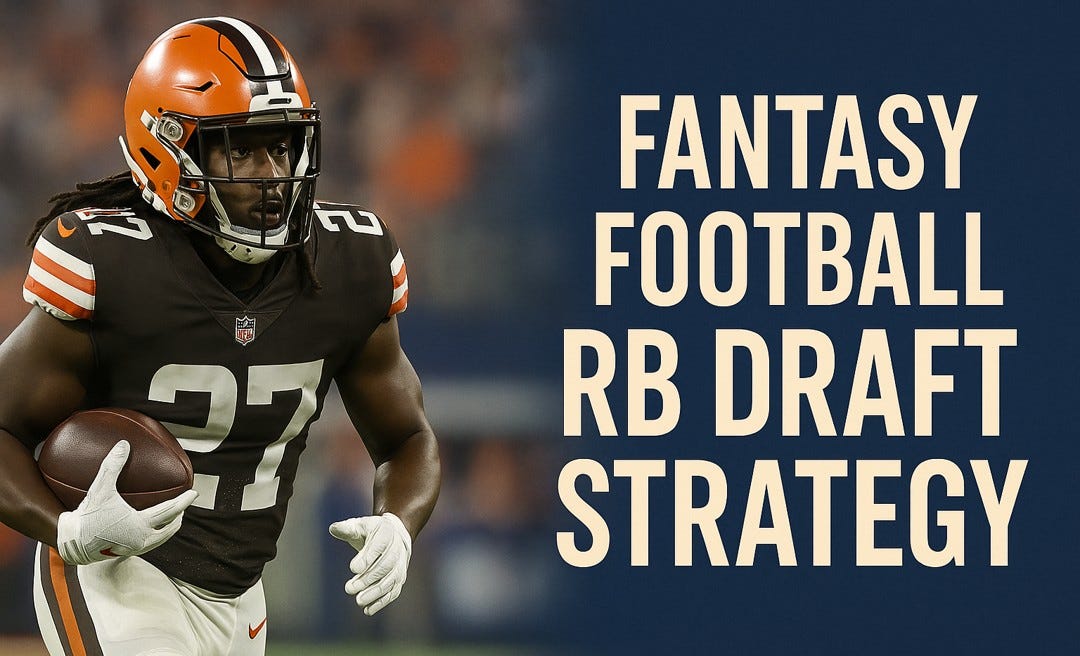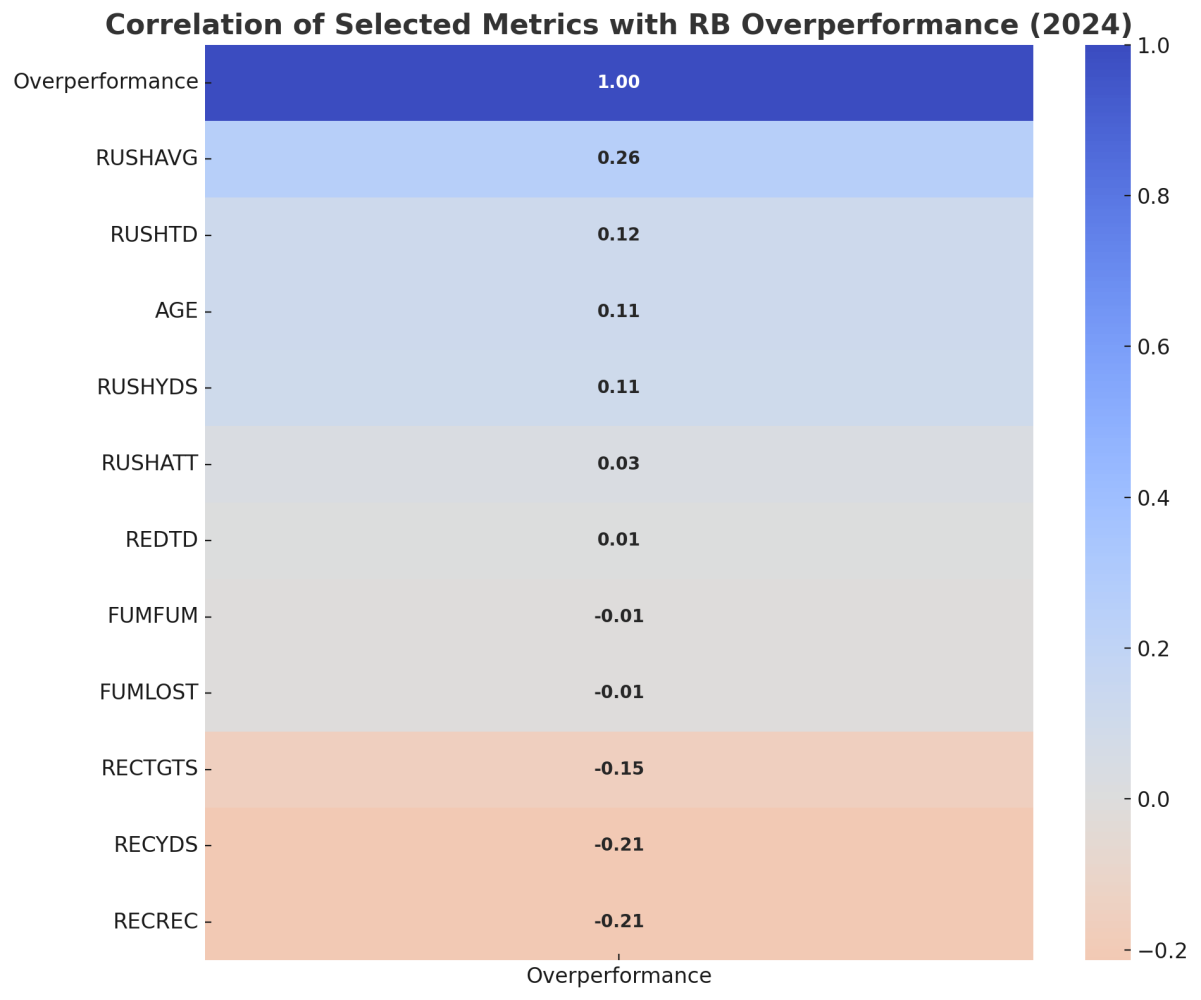Fantasy Football RB Draft Strategy: Why ADP Beat Projections and How to Spot 2025 Breakouts
Lessons Learned
Introduction
Draft day is where championships are won and mistakes are burned into memory. The clock is ticking, the room is buzzing with anticipation, and you’re staring at two names on your screen. One is an expert-projected star sitting near the top of every analyst’s list. The other has slightly lower projections but is steadily climbing in Average Draft Position (ADP), taken earlier and earlier in live drafts.
Who do you trust? Do you side with calculated models built on historical stats and regression analyses, or the collective wisdom of thousands of fantasy managers quietly signaling that this second player might be undervalued?
In the first article of this series, I analyzed quarterbacks from the 2024 fantasy season and found that expert projections slightly outperformed ADP. But running backs are a different story. Their production is notoriously volatile, with injuries, workload shifts, and goal-line touches that can swing a season, and understanding how well projections and ADP handle this chaos is critical for draft success.
This is the second article in a six-part series where I’m breaking down every fantasy position: Quarterbacks, Running Backs, Wide Receivers, Tight Ends, Kickers, and Defense/Special Teams, before wrapping up with a full analysis of draft accuracy across all positions.
For running backs, I’ll answer two big questions:
Which better predicted success in 2024: expert projections or ADP?
Could we have spotted breakout running backs before the season began, or were they truly unforeseeable diamonds in the rough?
To find out, I ran a statistical analysis of every running back from the 2024 season, combining data science with football intuition. I’ll show how projections stacked up against ADP, highlight the season’s biggest surprises, and reveal which preseason metrics hinted at breakout potential.
Data and Approach
Fantasy football analysis lives and dies by the data, so before I compared projections and ADP for running backs, I needed a dataset that captured not only rankings but also the underlying stats driving those expectations. I gathered data for every running back heading into the 2024 season, including their expert projections, Average Draft Position (ADP) across thousands of drafts, and their actual fantasy point totals.
I didn’t stop at ranks and points. I also pulled detailed projection metrics specific to running backs: rushing attempts, rushing yards, rushing average, rushing touchdowns, receiving targets, receptions, receiving yards, receiving touchdowns, fumbles, and player age. Having this level of granularity allowed me to go beyond asking who outperformed expectations and instead explore why certain running backs did.
Injuries are always a wild card, especially for running backs, who take more hits than any other position. To avoid skewing the results, I filtered out players who scored zero or near-zero fantasy points for the season. These black swan cases don’t tell us anything about the quality of projections or ADP; they just reflect bad luck. Removing them allowed me to focus on running backs who played enough to be fairly evaluated. I also filtered out those with projections under 100 points for the season to get the most relevant players as well.
Once cleaned, I converted projections, ADP, and actual outcomes into rankings. Rankings remove noise from raw fantasy point totals and allow for apples-to-apples comparisons. For example, if a running back was projected RB5, drafted as RB6, and finished RB2, rankings let me quantify that difference without worrying about exact point gaps.
To measure accuracy, I used three core metrics: 1/ Spearman’s Rank Correlation to see how closely preseason rankings matched final standings, 2/ Mean Absolute Error (MAE) to capture the average ranking miss, and 3/ Root Mean Squared Error (RMSE) to penalize big misses more heavily.
Finally, I calculated “overperformance,” defined as actual fantasy points minus projected fantasy points. This highlighted which running backs delivered well beyond expectations. By analyzing overperformance against detailed preseason stats, I explored whether traits like rushing efficiency, touchdown scoring, or even player age provided early indicators of breakout potential.
Projections vs ADP Accuracy
With the dataset ready, I set out to answer the first big question: Who did a better job predicting running back success in 2024: expert projections or ADP?
Projections are built from models that factor in past rushing and receiving production, offensive line strength, expected workload splits, and schedule difficulty. ADP, on the other hand, reflects the wisdom of the crowd. It’s shaped by thousands of fantasy managers drafting in real time, adjusting rankings based on training camp reports, preseason games, and gut feeling.
Here’s what I found:
Spearman correlation was 0.65 for projections versus 0.68 for ADP. A perfect score is 1.0, meaning every player finished exactly where ranked. This time, ADP slightly outperformed projections.
MAE came in at 6.12 for projections compared to 5.76 for ADP, meaning the crowd’s wisdom was, on average, about a third of a draft slot closer to reality.
RMSE was 7.92 for projections versus 7.67 for ADP, again showing that ADP made fewer big misses overall.
Running backs are notoriously volatile due to injuries, goal-line opportunities, and sudden workload shifts. This volatility often favors ADP because the drafting public collectively reacts to late-breaking information, such as camp reports or preseason depth chart moves, that static projection models can’t fully capture.
That doesn’t mean projections are useless. They still provide a strong baseline for evaluating talent and opportunity. But in 2024, if you had to break a tie between two running backs, leaning on ADP would have been slightly more reliable than trusting expert projections.
Diamonds in the Rough: 2024 RB Outperformers
While accuracy metrics tell part of the story, fantasy football isn’t won by drafting players who simply meet expectations; it’s won by finding the running backs who beat them. While these are not always late-round picks or even waiver-wire adds that turn into weekly must-starts and league winners, they frequently are just that.
In 2024, Jahmyr Gibbs led this group, delivering a breakout season for Detroit. Projected for 245 fantasy points, Gibbs exploded for 363, outscoring expectations by 118 points. Drafted as a mid-tier RB2 in many leagues, he emerged as an elite weapon, dominating both in the rushing and receiving game.
Close behind was Chuba Hubbard, who shocked managers by turning a projected 133 points into 242, a 109-point surge. Often undrafted or taken as a late flier, Hubbard became a pivotal fantasy starter for Carolina.
Veteran Derrick Henry showed he still had plenty left in the tank. Moving to Baltimore didn’t slow him down. He posted 336 points compared to a 235 projection, exceeding expectations by 102 points and proving doubters wrong.
Saquon Barkley followed a similar storyline, silencing concerns about his transition to Philadelphia. He turned a 257-point projection into 355 actual points, a 99-point overperformance, reminding everyone why he’s long been considered one of the league’s top backs.
Rounding out the top five of overperformers was Chase Brown, a Cincinnati back who emerged late in the season as a reliable contributor. Projected for just 161 points, he finished with 255, a 94-point breakout few saw coming.
Each of these players delivered far more value than both projections and ADP suggested, giving managers who trusted them a massive competitive advantage. Identifying these players before the season starts is what separates good drafts from championship rosters.
Searching for Predictive Clues
After seeing how dramatically some running backs outperformed their preseason expectations, I wanted to know whether there were warning signs, or better yet, hidden clues, in the projections that could have tipped us off to these breakouts before the season began.
The results weren’t overwhelmingly strong, as predicting running back breakouts is notoriously tough. But a few patterns emerged:
Rushing Efficiency Matters: Average yards per carry (RUSHAVG) had the strongest positive correlation with exceeding projections. Backs who were projected to be more efficient runners often delivered even better results than expected.
Touchdown Scoring Was Undervalued: Rushing touchdowns (RUSHTD) also showed a positive relationship with outperformance, suggesting projections slightly underestimated backs who converted red-zone opportunities into scores.
Age Bias: Older running backs had a mild positive correlation with overperformance, hinting at some “ageism” in projections. Veteran players like Derrick Henry proved they weren’t as past their prime as many projections implied.
Receiving Production Fell Short: Receiving metrics (targets, receptions, and yards) had negative correlations with overperformance. This means that pass-catching running backs underdelivered relative to their projected receiving stats, potentially due to offensive scheme changes or inflated preseason expectations.
No single metric acted as a crystal ball, but if I were drafting again, I’d be more willing to take chances on efficient rushers, touchdown-dependent backs, and undervalued veterans, while being cautious with backs whose fantasy value relies heavily on projected receiving volume.
Draft Strategy Implications
This analysis changed how I think about drafting running backs. I used to believe that receiving backs were the safest targets, as players who could rack up points through checkdowns and slot usage, even if rushing opportunities were limited. But the 2024 data told a different story: running backs projected for heavy receiving work consistently underperformed their expectations.
Instead, the traits most often tied to beating projections were:
Rushing Efficiency: Backs with higher projected yards per carry tended to outperform, signaling that analysts and models may still undervalue explosive, efficient runners.
Touchdown Upside: Goal-line backs or those with projected rushing TD opportunities delivered more value than anticipated.
Veteran Talent: Older running backs weren’t the liabilities projections suggested. Many seasoned players (like Derrick Henry and Saquon Barkley) proved they could still exceed expectations when given consistent workloads.
If I had to draft again, here’s how I’d adjust my approach:
I’d give extra consideration to efficient runners even if their projected touch counts were modest.
I’d be more willing to trust veterans when their draft price reflects skepticism about age.
I’d deprioritize receiving-focused RBs who rely mainly on projected targets for value, especially if their rushing efficiency is lacking.
When choosing between two similarly ranked backs, I’d lean toward those with a clearer path to goal-line carries and rushing TD potential.
Ultimately, running backs are a volatile position group, and no model or draft strategy can perfectly forecast breakout seasons. But 2024 showed that rushing efficiency, touchdown potential, and undervalued veterans offer the best shot at landing a true league-winning running back.






